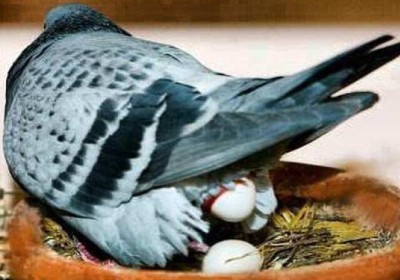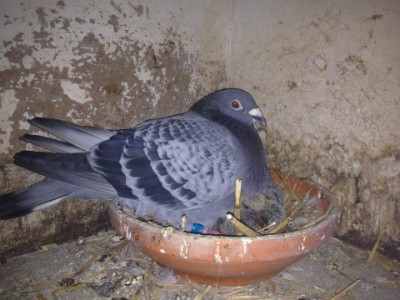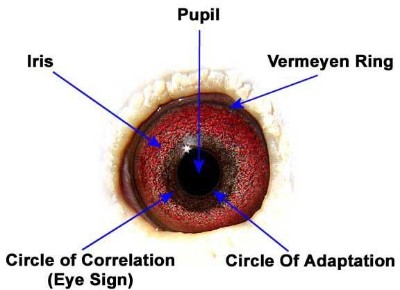|
BREEDING
Everything within the pigeon sport depends on quality. Quality has been present on the MVN-PIGEON lofts for years. But, the annual investments continue, because standing still in this sport means losing ground. Beside the introduction of these top pigeons, their own top lines are nurtured and improved. The pairing of the breeders is a serious undertaking. We are occupied for days on end determining the make-up of the various breeding pairs. We only want youngsters of the best possible couples.
If you look at the pigeon, does it show you charisma, does it look alert and shows it his character? Does the pigeon feel vital when you hold it? Does the pigeon look intelligent and looks around?
Good pigeons are always in balance. When you hold these pigeons, they lay flat in your hand, they tail doesn’t move to the right or the left. The back may be a little weaker but it is important that they are in proportion to each other. Hold that Ace pigeon and you will notice instantly: when you hold a good pigeon in your hands there are no faults.
Muscles are of great importance of the pigeon. Actually it is very simple short muscles are suited for short distance long muscles are suited to racing the long distance. Pigeons should have vibrating muscles along the breastbone. The must have this quality. Pigeons that don’t have it are the pigeons that burn-out quickly.
If you can’t feel muscles you can use something else. Look the pigeon in his throat. The split of the throat should lie deep within it so that you literally look over it. This split should be as small as possible. If the pigeon has good muscles and a good throat you don’t have to look any further, they have the potential to be good performers.
The feathering of the pigeon should feel like they have been waxed. A pigeon with fatty feathering can handle better the rain. You can see water drops rolling of his fatty, oily feathers. Everybody knows that newspaper in the rain falls together. This happens also by pigeons with dry feathers.
From L-R: Wout of Duivenvlucht.nl, Josef Hofmann, Marc van Nunen
Hofmann likes a small pupil as already mentioned, a well-developed circle of adaptation with serrated edges as well as speed and distance lines, and a very thick iris with "breeding grooves" which are black or dark in color. The circle of adaptation can be white, grey, black or yellow in color. Hofmann advises to pair birds of similarly colored circles of adaptation together but we, does not endorse this idea entirely. Moreover, what is the earliest time to evaluate eyes? The bird should be at least 14 to 15 months old. (We would assume that this is the age when breeding grooves become differentiated enough to be visible.) Josef Hoffmann believes that health and vitality can be read by looking at a pigeon's eye. Eye sign is useful for getting a higher percentage of good flying birds than by using some other methods. |
















 Every pigeon on our breeding stock has a genetic potential. The pigeon’s pedigree is important. We look for the extra class pigeon at both of their parents. We look for pigeons that not only delivered top performances on our loft but also on other lofts.
Every pigeon on our breeding stock has a genetic potential. The pigeon’s pedigree is important. We look for the extra class pigeon at both of their parents. We look for pigeons that not only delivered top performances on our loft but also on other lofts.  Everybody knows a bird without wings cannot fly. A chicken is not a gut and fast flyer, she has short round wings. A falcon is a gut and fast flyer. The falcon has long sharp powerful wings. If you open the wing it should not feel like you are holding a newspaper. The last four flights have enough ventilation and have a swallow shape type.
Everybody knows a bird without wings cannot fly. A chicken is not a gut and fast flyer, she has short round wings. A falcon is a gut and fast flyer. The falcon has long sharp powerful wings. If you open the wing it should not feel like you are holding a newspaper. The last four flights have enough ventilation and have a swallow shape type. Last but not least are the eyes of the pigeon. Many people heard about the eye signs of racing pigeons but don’t know to handle it. Josef Hofmann, a German eye sign enthusiast. He mains that it is need for breeders to have a small pupil, a well-developed circle of adaptation (preferably with serrated edges), and the usefulness of eye sign for finding the breeders in one's loft. It concedes that it is possible to breed very good racing pigeons without ever considering eye sign. However, he maintains that the percentage of good racing pigeons can be increased substantially by breeding only with birds with the eye sign common to good breeders.
Last but not least are the eyes of the pigeon. Many people heard about the eye signs of racing pigeons but don’t know to handle it. Josef Hofmann, a German eye sign enthusiast. He mains that it is need for breeders to have a small pupil, a well-developed circle of adaptation (preferably with serrated edges), and the usefulness of eye sign for finding the breeders in one's loft. It concedes that it is possible to breed very good racing pigeons without ever considering eye sign. However, he maintains that the percentage of good racing pigeons can be increased substantially by breeding only with birds with the eye sign common to good breeders.